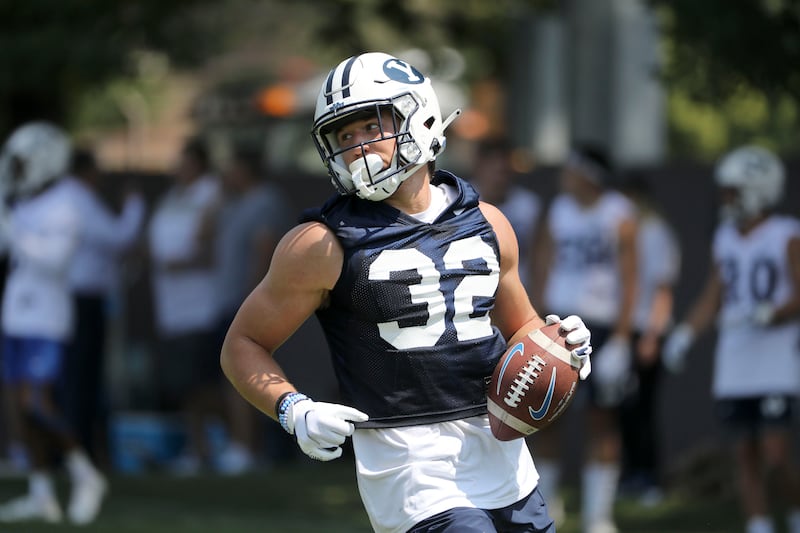In the world of tight ends and doughnuts, two is better than one.
BYU’s stacked attack at tight end is a luxury for Aaron Roderick’s offense and if history is any indication, it bodes well for the future.
During the days of Chad Lewis there was Itula Mili, and when Dennis Pitta roamed the middle of the field, there was Andrew George. Those tandems were tenacious.
When on the field together, Lewis and Mili combined for 217 receptions for 2,788 yards and 18 touchdowns during a three-year stretch where BYU went 31-8 between 1994-96.
Pitta and George combined for 291 receptions for 3,728 yards and 32 touchdowns during a 32-7 three-year run between 2007-09. Pitta’s individual marks of 2,901 career receiving yards remains the most for a BYU tight end and his 21 touchdowns is one shy of Gordon Hudson’s school record.
The duo of Isaac Rex and Dallin Holker have a long ways to go to catch their predecessors, but both Lewis and Pitta believe they are on their way.
“They are both hungry and versatile players — deadly in the red zone and super effective in the field,” said Lewis. “They should create nice mismatch problems for every defense we play this season.”
Isaac Rex
Rex is on the mend from a devastating ankle injury last season that kept him sidelined through spring practice. The redshirt sophomore from San Clemente, California, is back on the field and while not yet cleared for full combat, he is participating in drills and expects to be in the game at South Florida when BYU opens the season on Sept. 3.
“Isaac is a huge body. He can be a force at the line of scrimmage, and he is a match-up nightmare in the red zone,” said Pitta. “You can throw it up to him and he can go up and make tough, contested catches, which I think is so valuable as a tight end because when those windows get tight, you have to have a reliable guy that you can throw it up to and you know he will make a play.”
Rex has 15 touchdown receptions in two seasons, including a game-sealing grab against Arizona State last September when Baylor Romney threw it up — and the 6-foot-6, 247-pound target outjumped the defender to bring it down in the back of the end zone.
“He played a lot of basketball growing up and knows how to box out and rebound and make plays,” Lewis said. “He worked his butt off this offseason to do everything he could to get his foot ready to play. He is the kind of guy you want to have in the huddle.”
Dallin Holker
Holker brings his own size and strength to the tight end position, but the 6-5, 235-pound junior from Lehi also adds another element — speed.
“Dallin has the ability to stretch the field vertically,” Pitta said. “He can really run and create some mismatches in the pass game. I think they complement each other exceptionally well.”
Holker caught 14 passes for 200 yards and a touchdown last season. With Rex missing spring drills, he also received an abundance of offseason work.
“He has a great feel for the game. He runs great routes and has excellent hands,” Lewis said. “He definitely wants to leave his mark on the BYU history books.”
The mentors
When Lewis and Pitta speak, Rex and Holker listen. The pair of mentors have traveled a journey worth paying attention to. Lewis and Pitta started their college careers as walk-ons. Lewis was given a chance to compete after LaVell Edwards spent his lunch break watching him catch passes during a post-mission workout in 1994.
Pitta arrived as a hopeful receiver in 2004 and was relegated to a locker in the Smith Field House while the scholarship players suited up across the street in the new Student Athletic Building. He spent his initial spring camp being called “Dustin” by then-head coach Gary Crowton.
Both of them fought to get on the field and eventually earned scholarships. When given the chance, they produced and finished their BYU careers as decorated warriors. Lewis was named All-WAC and was later inducted into the BYU Hall of Fame in 2007. Pitta was a consensus All-American and with his college degree recently attained, a place for him in the Cougars’ Hall of Fame is on its way.

Both tight ends played in the NFL. Lewis caught two touchdowns in the 2005 NFC championship game to lead Philadelphia past Atlanta 27-10. Pitta marched Baltimore into the Super Bowl in 2012 and caught a touchdown pass as the Ravens beat San Francisco 34-31.
Both careers also had painful and early conclusions. Lewis suffered a Lisfranc injury to his left foot on the second touchdown grab against the Falcons. He missed the Super Bowl and the three-time Pro Bowl honoree never played again.
Pitta dislocated his right hip in training camp in 2013 following Baltimore’s Super Bowl victory. He worked his way back onto the field before dislocating it a second time in 2014 on a noncontact play against Cleveland.
After sitting out two years to heal, Pitta returned to the Ravens in 2016 and led all NFL tight ends and set Baltimore’s franchise record with 86 receptions to go along with a career-high 729 receiving yards. A third dislocation to his right hip during a noncontact drill in practice the following June ended his playing days for good.
In retirement, they are actively engaged in helping Rex and Holker get their careers started.
Attack the middle
Lewis and Pitta know the game. They know the tight end position and they know how impactful it can be.
“I know we have a ton of talented guys on the outside, but when you have talented tight ends, you have to find a way to get those guys the ball,” Pitta said. “Every good offense in the NFL understands that and they are looking for a tight end that can create mismatches on the inside. If you have that, you have got to utilize it.”
BYU’s production at tight end dropped significantly in 2021 as first-year starting quarterback Jaren Hall adjusted to the position. In 2020, Rex caught 37 passes from Zach Wilson for 429 yards and 12 touchdowns. Last year, before his injury in the regular-season finale, Rex had 18 receptions for 191 yards and three touchdowns.
“What separates a good quarterback from a great one is the ability to throw in the middle of the field,” Pitta said. “Young quarterbacks tend to throw more to the outside because it’s easier to read and easier to see. A quarterback that can dice you up in the middle and take those easy ones on the side when they are given, that’s a dangerous quarterback.
“If Jaren is able to do that, he’s gonna take a huge step in his maturation. It will take this offense to a whole new level if they can dice people up inside the hashes and also throw bombs and outside stuff to those talented receivers.”
Formula for success
As Pitta and George did their work inside the hashes it allowed for star receiver Austin Collie to take his game down the field, which opened lanes for running back Harvey Unga. With all of it combined, it gave Max Hall tremendous options on his way to becoming the winningest quarterback in BYU history.

A decade earlier, Lewis and Mili’s work in the middle opened up the outside for their talented group of receivers, including Ben Cahoon, Kaipo McGuire and K.O. Kealaluhi. The running backs shined too with Brian McKenzie and the lightning fast Ronney Jenkins. With those functioning tools, quarterback Steve Sarkisian steered BYU to its most wins in a single season (14-1) and a victory at the Cotton Bowl on New Year’s Day 1997.
Twenty-five years later, the formula for success remains unchanged. If Rex and Holker can torment the middle of the field like their predecessors, then receivers Puka Nacua, Gunner Romney, Keanu Hill and Chase Roberts should all find open lanes and single coverage down field. Cal-transfer Chris Brooks should see opportunities at the line of scrimmage for the ground attack behind a massive offensive line and quarterback Jaren Hall should face the same challenge as Hall and Sarkisian — so many options and just one football.
It’s a coveted conundrum and if you ask Pitta or Lewis — so many of the answers start at tight end with Rex and Holker.
“I really like how they are coming into the season with a chip on the shoulder. They feel like they have a lot to prove,” Lewis said. “There is nothing better than having two tight ends hungry to make plays.”
“They have both reached out for some help and guidance and I look forward to talking with them as the season progresses,” said Pitta. “Nobody is a bigger fan of those two guys than I am right now, and I hope they catch a lot of balls this year.”
Yes, when it comes to tight ends, or even doughnuts (especially the chocolate-iced kind), two is better than one.
Dave McCann is a contributor to the Deseret News and is the studio host of “After Further Review,” “Countdown to Kickoff,” “The PostGame Show,” and play-by-play announcer for BYUtv. He is also co-host of “Y’s Guys” at ysguys.com.



 alt=Dave McCann
alt=Dave McCann